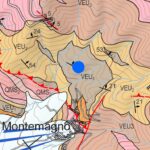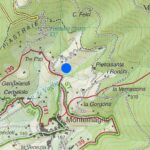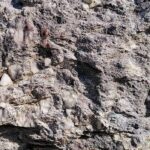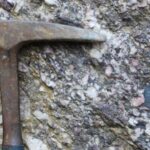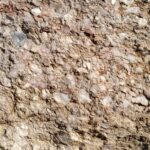A PARK ON MONTE PISANO
The park is situated on Monte Pisano, an isolated plateau with steep hills extending approximately 20 km from northwest to southeast between the Serchio Valley and the Arno Valley.
Monte Pisano didn’t always exist; it began to emerge above sea level about 8 million years ago, along with the Apuan Alps to the north and the Sienese Montagnola and Monti di Monticiano-Roccastrada to the south. All these elevations form a single mountain system known as the Tuscan Middle Backbone. Geologically speaking, it is a mountain that has emerged relatively recently, but the rocks that constitute it are very ancient, telling a history dating back nearly 500 million years.
Explore the extensive history of Monte Pisano!
The blue mark indicates the position of the park, and on the geological map, it corresponds to an area designated by the abbreviation VEU1. Geological maps display the rocks exposed in a given area, representing them with different colors and symbols. What does VEU1 represent?
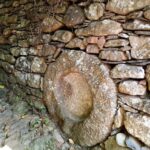 VEU1: THE ROCK OF THE PARK
VEU1: THE ROCK OF THE PARK
Throughout the park, a single type of rock outcrops, known as coarse anagenite, indicated on geological maps with the symbol VEU1. It dates back to around 240 – 232 million years ago, representing metamorphic rock and is part of a rock group called the Verruca Formation or Verrucano, named after the nearby mountain. The people of Monte Pisano used this rock to make millstones (photo).
WHAT ARE COARSE ANAGENITES MADE OF?
Coarse anagenites consist of rock fragments, recrystallized quartz, and traces of other minerals.
Quartz is the most abundant mineral, being highly durable and not altered over time. Rock fragments come from an older mountain range and were transported by watercourses. Among the various trace minerals, there is pyrophyllite.
Pyrophyllite is an aluminum (Al) phyllosilicate similar to talc, the magnesium (Mg) phyllosilicate that composes the famous talcum powder. Pyrophyllite, like talc, is a soft, light mineral with a smooth feel and a pearly or vitreous luster. It appears as crystals of white-yellowish, light green, or green-brown color, in the shape of thin plates or needles, arranged in radiating aggregates or clusters. The term “pyrophyllite” comes from Greek and means “leaf of fire” because it peels into thin layers when heated but does not melt!
Pyrophyllite crystals, 2 – 3 mm long, on quartz (photo by Christian Biagioni).
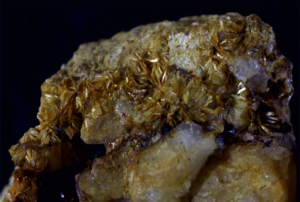
HISTORY OF COARSE ANAGENITES
AROUND 240 – 232 MILLION YEARS AGO, ROCKS FORMED…
The Verruca Formation dates back to around 240 – 232 million years ago, indicating that the Monte Pisano area was slightly north of the Equator at the time. It was in a savanna environment, in a plain surrounded by hills that were remnants of the ancient Hercynian Chain. The climate was hot and semiarid, with a rainy season during which temporary watercourses transported significant amounts of debris downstream in a short time. The Formation is composed of the accumulation of these debris and later became involved in metamorphic episodes linked to the Alpine orogeny, during which it acquired its current appearance.
The formation consists of three types of rocks that formed during different phases of high-water periods: coarse anagenites, violet shales, and minute anagenites.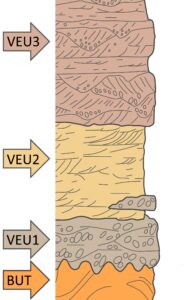 VEU1 – Coarse anagenites formed during phases of high energy when full watercourses were able to transport even the largest sediments, namely gravel. In subsequent dry periods, finer sediments were carried away by wind and accumulated in depressions, while the gravel remained in place. These gravels compacted and hardened into conglomerates, which then, following metamorphic episodes, transformed into the present coarse anagenites. VEU2 – Violet shales formed during the final phase of floods, during which mainly fine sediments, namely mud, were deposited. These muds later compacted and hardened into clay and silt rocks, which, due to metamorphic episodes, transformed into present phyllites. VEU3 – Minute anagenites formed during moister periods, with less violent floods. They are similar to coarse anagenites but consist of smaller elements, not exceeding 2 cm in diameter, and are much richer in quartz. These rock types are found in all coastal deposits from La Spezia to the Uccellina Mountains in southern Tuscany, indicating that the plain was extensive, with various unstable watercourses.
VEU1 – Coarse anagenites formed during phases of high energy when full watercourses were able to transport even the largest sediments, namely gravel. In subsequent dry periods, finer sediments were carried away by wind and accumulated in depressions, while the gravel remained in place. These gravels compacted and hardened into conglomerates, which then, following metamorphic episodes, transformed into the present coarse anagenites. VEU2 – Violet shales formed during the final phase of floods, during which mainly fine sediments, namely mud, were deposited. These muds later compacted and hardened into clay and silt rocks, which, due to metamorphic episodes, transformed into present phyllites. VEU3 – Minute anagenites formed during moister periods, with less violent floods. They are similar to coarse anagenites but consist of smaller elements, not exceeding 2 cm in diameter, and are much richer in quartz. These rock types are found in all coastal deposits from La Spezia to the Uccellina Mountains in southern Tuscany, indicating that the plain was extensive, with various unstable watercourses.
AROUND 30 MILLION YEARS AGO, ROCKS WERE MODIFIED…
The conglomerates were then modified (metamorphosed) when they encountered high temperatures and pressures during the processes that led to the formation of Monte Pisano, as seen today, ultimately becoming coarse anagenites. The main metamorphic process dates back to around 30 million years ago when the opening of the northern Atlantic Ocean led to the closure of the ancient Ligurian-Piedmontese Ocean. The collision of its two margins gave rise to the Apennine chain and the current relief of Monte Pisano. During the collision of the two margins, the rocks were deformed, developing folds under high temperatures and later faults at lower temperatures..
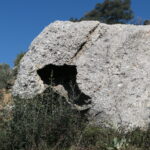 AROUND 100,000 YEARS AGO, ROCKS WERE ALTERED…
AROUND 100,000 YEARS AGO, ROCKS WERE ALTERED…
In the upper part of the park, the coarse anagenites take on peculiar fractured shapes. These formations are called TAFONI and were created by the action of moist, salt-laden sea winds. This means that the sea was once nearby! During the Ice Age, due to the accumulation of ice, the sea level was much lower than today. In warmer periods, known as interglacials, partial melting of the glaciers led to a rise in sea level, even higher than current levels. It was during one of these interglacial periods, between 120,000 and 80,000 years ago, that the TAFONI of Monte Pisano formed.
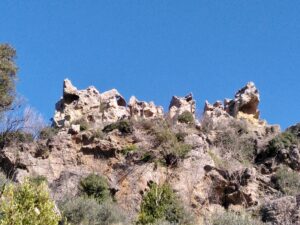
… AND THE CYCLE BEGINS AGAIN!
Through the erosion of these rocks over millions of years, new rocks will eventually form.
BUT – THE OLDEST ROCKS OF MONTE PISANO
The phyllites and quartzites of Buti are the oldest rocks of Monte Pisano, dating back to about 500 – 450 million years ago, during the Cambrian Period of the Paleozoic Era. They formed underwater due to the accumulation of mud and sand that later compacted into siltstones and sandstones. About 285 million years ago, during the Hercynian orogeny, they underwent metamorphism and transformed into phyllites and quartzites. They form the base upon which all the overlying sedimentary succession rests and terminate upward with an erosion surface indicating a period of emergence. They are indicated by the orange color and the BUT symbol, and as seen on the geological map, they also outcrop around the park.
In the Italian Peninsula, Paleozoic rocks only outcrop in certain areas of the Alpine chain, in Liguria and Tuscany. Among these, the oldest are those from the Cambrian Period, which outcrop only in Tuscany, along the Apuan Alps, Monte Pisano, the Sienese Montagnola, and the Monti di Monticiano-Roccastrada.
In-depth analysis: The extensive history of Monte Pisano!

